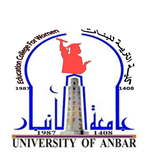
Article titled Justinian and his religious, administrative, judicial and commercial legislative works
.jpg)
Article titled Justinian and his religious, administrative, judicial and commercial legislative works
Dr.Nadia Mahmoud Farhan Al-Kahli
University of Anbar College of Education for Girls /Department of History, Iraq,
edw.nadeh_alkhlee@uoanbar.edu.iq
lavius ??Justinian (482-565 AD) was the most famous of the Byzantine Roman emperors. The Roman Empire in his reign (527-565) was the culmination of its power and greatness. He was born in a Macedonian village to a Latin-peasant family called Peter Spatius, to be adopted by his uncle the military commander and subsequent emperor Justin (518-527) Justin.
Received an excellent education and tomorrow of the greatest men of his time culture. He began his political career in the reign of his uncle. He held a number of high-ranking posts in the Consulate in 520. He participated in the responsibility of the government and was awarded the title of August, the successor to the Crown Prince, and succeeded his uncle Justin on the throne of the empire in 527 AD.
Justinian had a deep sense of the past of the great Roman Empire, and was determined to send its glories to restore its western parts from the hands of theGermanic tribes and kingdoms, to reform administrative disadvantages and to collect and codify its legal system. He was also a very religious man who believed that the greatness of the empire was linked to the unity of its beliefs, the suppression of heresies and the elimination of the last manifestations ofpaganism. .
One of the most famous works of Justinian, the greatest and most influential of which was the collection and codification of Roman rights in his reign, in what became known as the "Cropus Luris Civilis" (or the four-part civil law group: the law, the chosen, the laws, the innovations) Has become a source of basic legal norms in Europe and many countries of the world.
Justinian also made many reforms in the field of administration, government and the judiciary. He concentrated all powers on the emperor and his government. He also tried to unify the religious faith in the empire and fight other heresies and doctrines. To this end he set up a church complex in Constantinople in 553 but with little success. He also made great efforts to spread the Orthodox Christian religion in the Danube and Eastern Europe as a means of consolidating Byzantine influence in those areas.
His era witnessed the discovery of the mystery of the silk industry and the smuggling of silkworms from China. This was the beginning of the famous Byzantine silk industry in Constantinople, Antioch, Beirut and Alexandria, which gave the state great profits. The Church of St. Sophia in Constantinople, which is one of the finest achievements of Byzantine architecture, also includes the churches of Ravenna Italian masterpieces of mosaics, including the famous painting depicting Justinian with his wife Theodora and their imperial entourage at the end The Eastern Roman Empire reached the peak of its glory under the rule of Justinian, and although its wars in the west and east exhausted its forces and exhausted many of its economic and human resources, its historical vision, legislation and urban monuments In the sixth century AD, it was worth the century of Justinian, who boasts of his victories and titles in the foreword of his famous blog, and decides that: "For the state to rule in good time in time of peace and in time of war, It seemed to rely on two pillars: weapons and laws.."
To download the article, click here




